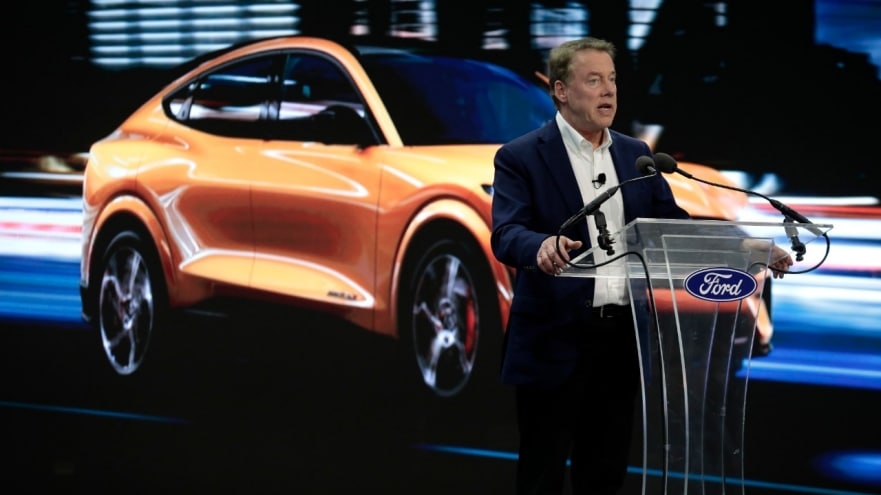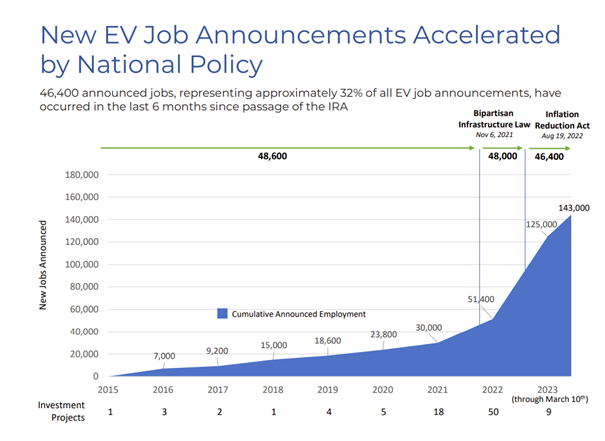
The Environmental Defense Fund and WSP USA highlight how transitioning to cleaner vehicles is already providing a huge boost to the economy.
The United Nations Intergovernmental Panel on Climate Change announced on Monday that if humans do not quickly move away from using fossil fuels, the world is likely to warm to a dangerous temperature threshold within 10 years.
But as the saying goes, in the midst of every crisis comes great opportunity.
Another new report, this one issued by the Environmental Defense Fund (EDF) and consultancy group WSP USA, highlights how the passage of the climate-focused Inflation Reduction Act (IRA) has “catalyzed already thriving investments in electric vehicle manufacturing in the U.S.” More than $120 billion in EV investments and 143,000 new jobs have been announced in the United States over the last eight years, and more than 40% have happened since passage of the IRA six months ago.
On the jobs front, 66% of the 143,000 new jobs have been announced in the past 15 months, since the passage of the Bipartisan Infrastructure Law; 32% were unveiled within the past six months. A bulk of the job growth is happening in the EV battery industry, with 61,700 new jobs in that sector. Passenger vehicles follows close behind at 55,800 new jobs.
And job growth is happening throughout the United States. Michigan leads the way, but other states that have seen big investment include Tennessee, Georgia, Nevada, Kentucky, South Carolina, Ohio, North Carolina, Indiana, Kansas, Arizona, California, Alabama, Texas, and Illinois.
There’s no doubt that industrial policy is driving this economic growth. The Bipartisan Infrastructure Act provided the first big push, and the IRA really propelled things forward.

All of this job and economic growth also will likely play a big role in helping lower carbon emissions, because America’s EV factories will be able to manufacture around 4.3 million new passenger vehicles every year starting in 2026. That represents about one-third of the vehicles sold in 2022. The battery supply chain is also starting to take shape, as U.S. battery plants will be capable of producing enough to supply 11.2 million new passenger vehicles each year by 2026, which represents about 84% of new vehicles sold last year.
Peter Zalzal, EDF’s associate vice president for Clean Air Strategies, said the investments stemming from the IRA and infrastructure legislation have launched “an American vehicle manufacturing renaissance.” And there will likely be more room for EV sector growth, as the Environmental Protection Agency is set to unveil new emissions standards, including for heavy duty vehicles like freight trucks and buses.
The current news about the climate is dire, but there’s reason to be hopeful. Environmental groups like EDF have described IRA as a victory for the climate and “a huge step forward in the fight to preserve a livable planet.” After decades of delay, we are finally on the right track.
The United States certainly cannot go it alone if we want to turn the climate tide — China and India, among other nations, will also have to act. But as I argued earlier this month, real action on climate will not happen via international treaties or diplomatic summits. If the United States is serious about lowering carbon emissions, it needs to lead the way via its actions.
And as this new EDF report shows, there is bound to be a whole host of benefits beyond preserving our planet. The United States must see the promise of the IRA through, and continue to make smart industrial policy decisions that will drive both a cleaner future and a stronger economy.
